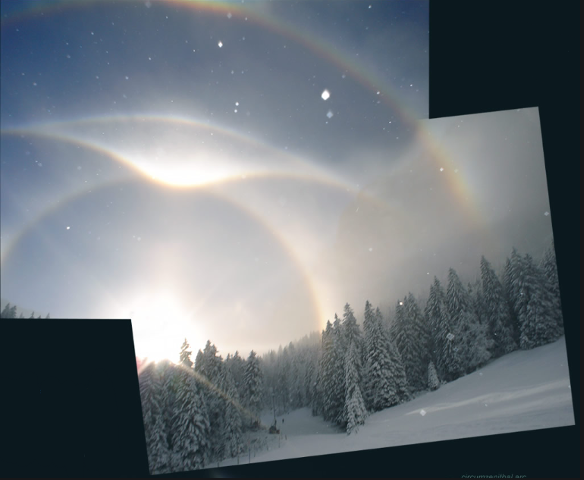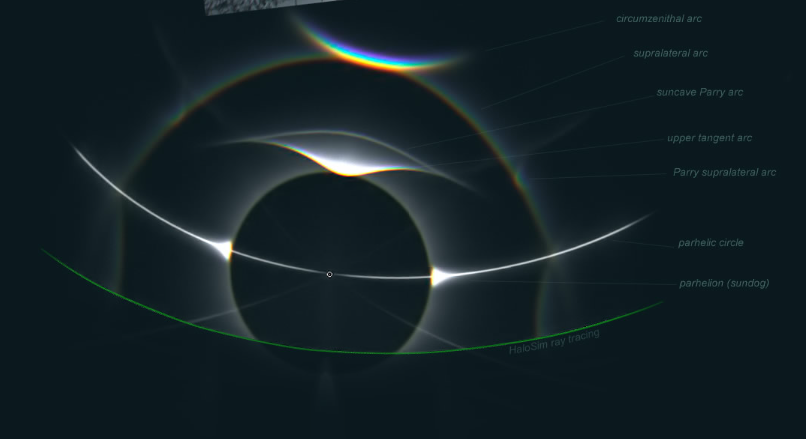OPOD - Swiss Halos
Swiss Halos: A Rare Atmospheric Optics Phenomenon
Have you ever heard of Swiss Halos? These captivating atmospheric optics phenomena are a sight to behold. Recently, Max Emerson had the opportunity to capture these stunning halos in the Melchsee-Frutt region of Switzerland, and the images he captured are truly remarkable.
When it comes to halos, there are various types and formations that can occur in the sky. However, the Swiss Halos observed in this region are particularly unique and extraordinary. The display of halos witnessed by Max Emerson is exceptional and offers a rare glimpse into the wonders of atmospheric optics.
In the captivating images taken by Max Emerson, we can observe the presence of the helic and Parry supralateral arcs. These arcs are incredibly rare and add to the allure of the Swiss Halos. To understand these phenomena further, let's delve into the fascinating world of atmospheric optics and explore the science behind these remarkable displays.
Understanding Swiss Halos through Ray Tracing Simulation
To gain a deeper understanding of the Swiss Halos observed in the Melchsee-Frutt region, HaloSim ray tracing simulations have been conducted. These simulations help identify and analyze the various halos present in the images captured by Max Emerson.
Through the ray tracing simulation, scientists and researchers can study the intricate details of the halos, their formations, and their characteristics. This allows for a comprehensive analysis of the Swiss Halos, providing valuable insights into their origins and behavior.
The Helic and Parry Supralateral Arcs: Rare Gems in the Sky
Among the halos observed in the Swiss Halos display, two particularly rare and captivating phenomena stand out: the helic and Parry supralateral arcs. These arcs add an extra layer of complexity and beauty to the already mesmerizing scene.
The helic arc, also known as the heliac arc, is a halo that forms a circular or elliptical shape around the sun or moon. It is characterized by a series of bright spots or arcs that curve in a helical pattern. This phenomenon is quite rare and requires specific atmospheric conditions for its formation.
Similarly, the Parry supralateral arc is a halo that appears above the 22-degree halo. It is characterized by its position above the main halo and its elongated shape. This arc is also quite rare and adds a touch of elegance to the overall halo display.
Exploring the Beauty of Atmospheric Optics
Atmospheric optics is a captivating field of study that explores the various optical phenomena that occur in the Earth's atmosphere. From rainbows to halos, these phenomena are created by the interaction of light with ice crystals, water droplets, and other atmospheric particles.
Swiss Halos, like many other atmospheric optics phenomena, rely on the presence of ice crystals in the atmosphere. These crystals act as tiny prisms, refracting and reflecting light to create the stunning displays we observe. The specific shapes and orientations of the ice crystals determine the unique characteristics of each halo formation.
The Influence of Weather Conditions on Swiss Halos
The formation of Swiss Halos is heavily influenced by weather conditions. Cold temperatures and high humidity levels create an environment conducive to the formation of ice crystals in the atmosphere. When these ice crystals align in a specific manner, they give rise to the intricate patterns and arcs seen in Swiss Halos.
Additionally, the altitude and geographical location play a role in the occurrence of these halos. The Melchsee-Frutt region of Switzerland, with its mountainous terrain and unique atmospheric conditions, provides an ideal setting for the formation of these rare halos.
Appreciating the Rarity and Beauty of Swiss Halos
Swiss Halos are truly a sight to behold. Their rarity and intricate formations make them a subject of fascination for scientists, photographers, and nature enthusiasts alike. Capturing these phenomena in photographs allows us to appreciate the beauty and complexity of the natural world.
As we continue to explore the wonders of atmospheric optics, it is important to cherish and protect these natural displays. They serve as a reminder of the incredible forces at play in our atmosphere and the delicate balance that exists in our environment.
So, next time you find yourself gazing at the sky, keep an eye out for the enchanting Swiss Halos. You never know when you might be lucky enough to witness these rare gems illuminating the heavens above.

Swiss Halos
Mountain diamond dust halos in the Melchsee-Frutt region of Switzerland. Max Emerson took these images. ©Max Emerson, shown with permission
The halos are identified in the HaloSim ray tracing simulation below.
The display is exceptional.
The helic and Parry supralateral arcs are very rare.

Note: this article has been automatically converted from the old site and may not appear as intended. You can find the original article here.
Reference Atmospheric Optics
If you use any of the definitions, information, or data presented on Atmospheric Optics, please copy the link or reference below to properly credit us as the reference source. Thank you!
-
<a href="https://atoptics.co.uk/blog/opod-swiss-halos-2/">OPOD - Swiss Halos</a>
-
"OPOD - Swiss Halos". Atmospheric Optics. Accessed on November 26, 2024. https://atoptics.co.uk/blog/opod-swiss-halos-2/.
-
"OPOD - Swiss Halos". Atmospheric Optics, https://atoptics.co.uk/blog/opod-swiss-halos-2/. Accessed 26 November, 2024
-
OPOD - Swiss Halos. Atmospheric Optics. Retrieved from https://atoptics.co.uk/blog/opod-swiss-halos-2/.